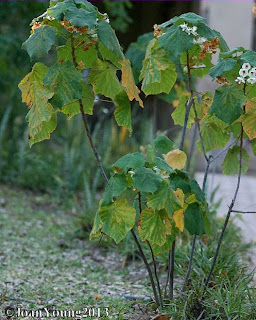Family Sterculiaceae
Distribution: The silver white pear occurs mainly on the northeastern Drakensberg from Swaziland, through Mphumalanga to the lower parts of Limpopo Province. It has a somewhat restricted distribution, as it grows on rocky hillsides or mountains at high altitudes, in wooded kloofs or in wooded areas along stream banks.
Description:
This plant can be classified as a shrub or small tree of up to 5 m in height depending on the area it occurs in. It is multi-stemmed and the slender branches are smooth, wrinkled and often covered with glandular hairs.
The velvety leaves n vary in size from 40 to 200 mm in diameter, are roundish to roughly triangular with the upper half sometimes lobed. The tips are pointed, the bases deeply indented and the margins roundly toothed with 5-7 prominent veins that arise from the base on the lower surface. The upper surface of the leaves is green and covered with short, dense hairs, whereas the undersurface is covered in silvery or greyish white, velvety hairs.
The velvety buds open into white flowers that often display a deep pink centre. They turn brown later. The flowers are borne on hairy stalks in bunches in the axils of the upper leaves. Flowering time: December to May. The fruit is a capsule and is covered with dense, yellowish hairs. The seeds are small, brown and pitted and are ripe between March and June.
Derivation of name and historical aspects: The generic name Dombeya, is in honour of Joseph Dombey, a French botanist and traveller in Peru and Chile (1742-1793). The specific name pulchra comes from the Latin word for beautiful.
Info: http://www.plantzafrica.com




